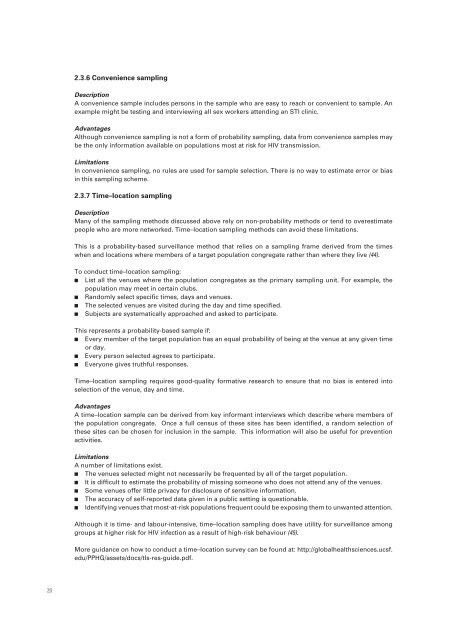Guidelines on surveillance among populations most at risk for HIV
Guidelines on surveillance among populations most at risk for HIV
Guidelines on surveillance among populations most at risk for HIV
- No tags were found...
Create successful ePaper yourself
Turn your PDF publications into a flip-book with our unique Google optimized e-Paper software.
2.3.6 C<strong>on</strong>venience samplingDescripti<strong>on</strong>A c<strong>on</strong>venience sample includes pers<strong>on</strong>s in the sample who are easy to reach or c<strong>on</strong>venient to sample. Anexample might be testing and interviewing all sex workers <strong>at</strong>tending an STI clinic.AdvantagesAlthough c<strong>on</strong>venience sampling is not a <strong>for</strong>m of probability sampling, d<strong>at</strong>a from c<strong>on</strong>venience samples maybe the <strong>on</strong>ly in<strong>for</strong>m<strong>at</strong>i<strong>on</strong> available <strong>on</strong> popul<strong>at</strong>i<strong>on</strong>s <strong>most</strong> <strong>at</strong> <strong>risk</strong> <strong>for</strong> <strong>HIV</strong> transmissi<strong>on</strong>.Limit<strong>at</strong>i<strong>on</strong>sIn c<strong>on</strong>venience sampling, no rules are used <strong>for</strong> sample selecti<strong>on</strong>. There is no way to estim<strong>at</strong>e error or biasin this sampling scheme.2.3.7 Time–loc<strong>at</strong>i<strong>on</strong> samplingDescripti<strong>on</strong>Many of the sampling methods discussed above rely <strong>on</strong> n<strong>on</strong>-probability methods or tend to overestim<strong>at</strong>epeople who are more networked. Time–loc<strong>at</strong>i<strong>on</strong> sampling methods can avoid these limit<strong>at</strong>i<strong>on</strong>s.This is a probability-based <strong>surveillance</strong> method th<strong>at</strong> relies <strong>on</strong> a sampling frame derived from the timeswhen and loc<strong>at</strong>i<strong>on</strong>s where members of a target popul<strong>at</strong>i<strong>on</strong> c<strong>on</strong>greg<strong>at</strong>e r<strong>at</strong>her than where they live (44).To c<strong>on</strong>duct time–loc<strong>at</strong>i<strong>on</strong> sampling: List all the venues where the popul<strong>at</strong>i<strong>on</strong> c<strong>on</strong>greg<strong>at</strong>es as the primary sampling unit. For example, thepopul<strong>at</strong>i<strong>on</strong> may meet in certain clubs. Randomly select specific times, days and venues. The selected venues are visited during the day and time specified. Subjects are system<strong>at</strong>ically approached and asked to particip<strong>at</strong>e.This represents a probability-based sample if: Every member of the target popul<strong>at</strong>i<strong>on</strong> has an equal probability of being <strong>at</strong> the venue <strong>at</strong> any given timeor day. Every pers<strong>on</strong> selected agrees to particip<strong>at</strong>e. Every<strong>on</strong>e gives truthful resp<strong>on</strong>ses.Time–loc<strong>at</strong>i<strong>on</strong> sampling requires good-quality <strong>for</strong>m<strong>at</strong>ive research to ensure th<strong>at</strong> no bias is entered intoselecti<strong>on</strong> of the venue, day and time.AdvantagesA time–loc<strong>at</strong>i<strong>on</strong> sample can be derived from key in<strong>for</strong>mant interviews which describe where members ofthe popul<strong>at</strong>i<strong>on</strong> c<strong>on</strong>greg<strong>at</strong>e. Once a full census of these sites has been identified, a random selecti<strong>on</strong> ofthese sites can be chosen <strong>for</strong> inclusi<strong>on</strong> in the sample. This in<strong>for</strong>m<strong>at</strong>i<strong>on</strong> will also be useful <strong>for</strong> preventi<strong>on</strong>activities.Limit<strong>at</strong>i<strong>on</strong>sA number of limit<strong>at</strong>i<strong>on</strong>s exist. The venues selected might not necessarily be frequented by all of the target popul<strong>at</strong>i<strong>on</strong>. It is difficult to estim<strong>at</strong>e the probability of missing some<strong>on</strong>e who does not <strong>at</strong>tend any of the venues. Some venues offer little privacy <strong>for</strong> disclosure of sensitive in<strong>for</strong>m<strong>at</strong>i<strong>on</strong>. The accuracy of self-reported d<strong>at</strong>a given in a public setting is questi<strong>on</strong>able. Identifying venues th<strong>at</strong> <strong>most</strong>-<strong>at</strong>-<strong>risk</strong> popul<strong>at</strong>i<strong>on</strong>s frequent could be exposing them to unwanted <strong>at</strong>tenti<strong>on</strong>.Although it is time- and labour-intensive, time–loc<strong>at</strong>i<strong>on</strong> sampling does have utility <strong>for</strong> <strong>surveillance</strong> am<strong>on</strong>ggroups <strong>at</strong> higher <strong>risk</strong> <strong>for</strong> <strong>HIV</strong> infecti<strong>on</strong> as a result of high-<strong>risk</strong> behaviour (45).More guidance <strong>on</strong> how to c<strong>on</strong>duct a time–loc<strong>at</strong>i<strong>on</strong> survey can be found <strong>at</strong>: http://globalhealthsciences.ucsf.edu/PPHG/assets/docs/tls-res-guide.pdf.20















